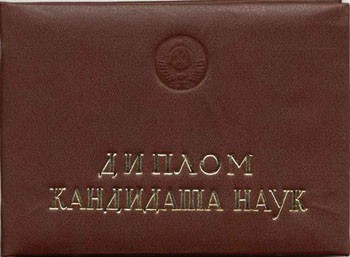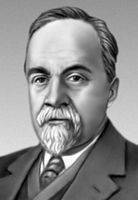|
Ivan Antonovich Efremov
Ivan Antonovich (real patronymic Antipovich) Yefremov ( ru , Ива́н Анто́нович (Анти́пович) Ефре́мов; April 23, 1908 – October 5, 1972; last name sometimes transliterated as Efremov) was a Soviet paleontologist, science-fiction author and social thinker. He founded taphonomy, the study of fossilization patterns. Biography He was born in the village of Vyritsa in Saint Petersburg Governorate on April 23, 1908. His parents divorced during the Russian Revolution. His mother married a Red Army commander and left the children in Kherson to be cared for by an aunt who soon died of typhus. Yefremov survived on his own for some time, after which he joined a Red Army unit as a "son of the regiment" and went to Perekop with it. In 1921, he was discharged and went to Petrograd (today's Saint Petersburg) to study. He completed his education there while combining his studies with a variety of odd jobs. He later commented that "the Revolution was als ... [...More Info...] [...Related Items...] OR: [Wikipedia] [Google] [Baidu] |
Gatchinsky District
Gatchinsky District (russian: Га́тчинский райо́н) is an administrativeOblast Law #32-oz and municipalLaw #113-oz district (raion), one of the seventeen in Leningrad Oblast, Russia. It is located in the southwestern central part of the oblast and borders with Krasnoselsky, Moskovsky, and Pushkinsky Districts of the federal city of St. Petersburg in the north, Tosnensky District in the east, Luzhsky District in the south, Volosovsky District in the west, and with Lomonosovsky District in the northwest. The area of the district is .Kozhevnikov, p. 61 Its administrative center is the town of Gatchina. Population (excluding the administrative center): 132,010 ( 2002 Census); Geography The northern part of the district is essentially a mixture of urban areas - suburbs of Saint Petersburg - and summer house areas. The central and the southern parts are forested. Much of the area of the district belongs to the drainage basin of the Luga River, a tributary ... [...More Info...] [...Related Items...] OR: [Wikipedia] [Google] [Baidu] |
Typhus
Typhus, also known as typhus fever, is a group of infectious diseases that include epidemic typhus, scrub typhus, and murine typhus. Common symptoms include fever, headache, and a rash. Typically these begin one to two weeks after exposure. The diseases are caused by specific types of bacterial infection. Epidemic typhus is due to ''Rickettsia prowazekii'' spread by body lice, scrub typhus is due to ''Orientia tsutsugamushi'' spread by chiggers, and murine typhus is due to ''Rickettsia typhi'' spread by fleas. Vaccines have been developed, but none are commercially available. Prevention is achieved by reducing exposure to the organisms that spread the disease. Treatment is with the antibiotic doxycycline. Epidemic typhus generally occurs in outbreaks when poor sanitary conditions and crowding are present. While once common, it is now rare. Scrub typhus occurs in Southeast Asia, Japan, and northern Australia. Murine typhus occurs in tropical and subtropical areas of the worl ... [...More Info...] [...Related Items...] OR: [Wikipedia] [Google] [Baidu] |
Candidate Of Science
Candidate of Sciences (russian: кандидат наук, translit=kandidat nauk) is the first of two doctoral level scientific degrees in Russia and the Commonwealth of Independent States. It is formally classified as UNESCO's ISCED level 8, "doctoral or equivalent". It may be recognized as Doctor of Philosophy, usually in natural sciences, by scientific institutions in other countries. Former Soviet countries also have a more advanced degree, Doctor of Sciences. Overview The degree was first introduced in the USSR on 13 January 1934 by a decision of the Council of People's Commissars of the USSR, all previous degrees, ranks and titles having been abolished immediately after the October Revolution in 1917. Academic distinctions and ranks were viewed as survivals of capitalist inequality and hence were to be permanently eliminated. The original decree also recognized some degrees earned prior to 1917 in Tsarist Russia and elsewhere. To attain the Candidate of Sciences de ... [...More Info...] [...Related Items...] OR: [Wikipedia] [Google] [Baidu] |
Central Asia
Central Asia, also known as Middle Asia, is a subregion, region of Asia that stretches from the Caspian Sea in the west to western China and Mongolia in the east, and from Afghanistan and Iran in the south to Russia in the north. It includes the former Soviet Union, Soviet republics of the Soviet Union, republics of Kazakhstan, Kyrgyzstan, Tajikistan, Turkmenistan, and Uzbekistan, which are colloquially referred to as the "-stans" as the countries all have names ending with the Persian language, Persian suffix "-stan", meaning "land of". The current geographical location of Central Asia was formerly part of the historic region of Turkestan, Turkistan, also known as Turan. In the pre-Islamic and early Islamic eras ( and earlier) Central Asia was inhabited predominantly by Iranian peoples, populated by Eastern Iranian languages, Eastern Iranian-speaking Bactrians, Sogdians, Khwarezmian language, Chorasmians and the semi-nomadic Scythians and Dahae. After expansion by Turkic peop ... [...More Info...] [...Related Items...] OR: [Wikipedia] [Google] [Baidu] |
Ural Mountains
The Ural Mountains ( ; rus, Ура́льские го́ры, r=Uralskiye gory, p=ʊˈralʲskʲɪjə ˈɡorɨ; ba, Урал тауҙары) or simply the Urals, are a mountain range that runs approximately from north to south through western Russia, from the coast of the Arctic Ocean to the river Ural and northwestern Kazakhstan.Ural Mountains Encyclopædia Britannica on-line The mountain range forms part of the conventional boundary between the regions of and |
Volga Region
The Volga Region (russian: Поволжье, ''Povolzhye'', literally: "along the Volga") is a historical region in Russia that encompasses the drainage basin of the Volga River, the longest river in Europe, in central and southern European Russia. The Volga Region is culturally separated into three sections: * Upper Volga Region - from the Volga River's source (river), source in Tver Oblast to the Mouth (river), mouth of the Oka River in Nizhny Novgorod * Middle Volga Region - from the mouth of the Oka River to the mouth of the Kama River south of Kazan * Lower Volga Region - from the mouth of the Kama River to the Volga Delta in the Caspian Sea, in Astrakhan Oblast The geographic boundaries of the region are vague, and the term "Volga Region" is used to refer primarily to the Middle and Lower sections, which are included in the Volga Federal District and Volga economic region. Geography The Volga Region is almost entirely within the East European Plain, with a notable disti ... [...More Info...] [...Related Items...] OR: [Wikipedia] [Google] [Baidu] |
Linnean Society Of London
The Linnean Society of London is a learned society dedicated to the study and dissemination of information concerning natural history, evolution, and taxonomy. It possesses several important biological specimen, manuscript and literature collections, and publishes academic journals and books on plant and animal biology. The society also awards a number of prestigious medals and prizes. A product of the 18th-century enlightenment, the Society is the oldest extant biological society in the world and is historically important as the venue for the first public presentation of the theory of evolution by natural selection on 1 July 1858. The patron of the society was Queen Elizabeth II. Honorary members include: King Charles III of Great Britain, Emeritus Emperor Akihito of Japan, King Carl XVI Gustaf of Sweden (both of latter have active interests in natural history), and the eminent naturalist and broadcaster Sir David Attenborough. History Founding The Linnean Society ... [...More Info...] [...Related Items...] OR: [Wikipedia] [Google] [Baidu] |
Alexey Bystrow
Alexey Petrovich Bystrow, sometimes spelled Alexey Petrovich Bystrov and Aleksei Petrovich Bystrow, (russian: Алексе́й Петро́вич Быстро́в; February 1, 1899 – August 29, 1959) was a Soviet paleontologist, anatomist, and histologist. Biography Born in the village of Tarasovo in Ryazan Governorate on 1 February 1899. His father was a Russian Orthodox protopriest and his mother was a school teacher. Bystrow's articles in English Bystrow, A.P. ''Kotlassia prima'' Amalitzky. Bulletin of the Geological Society of America, Washington, 1944, v.55, N5, pp.379-416.* Bystrow, A.P. Hydrophilous and Xerophilous Labyrinthodonts. Acta Zool., Stockholm, A.Bonniers forlag, 1947, v.28, N1, pp. 137–164. * Bystrow, A.P. The microstructure of dermal bones in Arthrodires. Acta Zool., Stockholm, A. Bonniers forlag, 1957, v.38, N2-3, pp. 239–275. * Bystrow, A.P. The microstructure of skeleton elements in some vertebrates from lower Devonian deposits of the ... [...More Info...] [...Related Items...] OR: [Wikipedia] [Google] [Baidu] |
Saint Petersburg State University
Saint Petersburg State University (SPBU; russian: Санкт-Петербургский государственный университет) is a public research university in Saint Petersburg, Russia. Founded in 1724 by a decree of Peter the Great, the university from the beginning has had a focus on fundamental research in science, engineering and humanities. During the Soviet period, it was known as Leningrad State University (russian: Ленинградский государственный университет). It was renamed after Andrei Zhdanov in 1948 and was officially called "Leningrad State University, named after A. A. Zhdanov and decorated with the Order of Lenin and the Order of the Red Banner of Labour." Zhdanov's was removed in 1989 and Leningrad in the name was officially replaced with Saint Petersburg in 1992. It is made up of 24 specialized faculties (departments) and institutes, the Academic Gymnasium, the Medical College, the College of Physical Culture ... [...More Info...] [...Related Items...] OR: [Wikipedia] [Google] [Baidu] |
Paleontology
Paleontology (), also spelled palaeontology or palæontology, is the scientific study of life that existed prior to, and sometimes including, the start of the Holocene epoch (roughly 11,700 years before present). It includes the study of fossils to classify organisms and study their interactions with each other and their environments (their paleoecology). Paleontological observations have been documented as far back as the 5th century BC. The science became established in the 18th century as a result of Georges Cuvier's work on comparative anatomy, and developed rapidly in the 19th century. The term itself originates from Greek (, "old, ancient"), (, ( gen. ), "being, creature"), and (, "speech, thought, study"). Paleontology lies on the border between biology and geology, but differs from archaeology in that it excludes the study of anatomically modern humans. It now uses techniques drawn from a wide range of sciences, including biochemistry, mathematics, and engineering. ... [...More Info...] [...Related Items...] OR: [Wikipedia] [Google] [Baidu] |
Petr Sushkin
Petr Petrovich Sushkin (russian: Петр Петрович Сушкин; 27 January 1868 – 17 September 1928) was a Russian ornithologist who specialised on comparative anatomy, and evolution of birds, particularly of the birds of prey. Sushkin was born in Tula, Russia, in a merchant family. He studied at the Tula Classical Gymnasium (1877-1885) graduating with a silver medal before going on to Moscow University in 1885. He graduated in 1890 and joined the staff of the Leningrad Zoological Museum in 1898. He studied ornithology under Mikhail Menzbier and his dissertation in 1897 was on the morphology of the skeleton of birds, specifically of the kestrel. He conducted surveys in the Ufa province in 1891 and Kazakhstan in 1898. His studies on the birds of southeastern Russia, Siberia and the Altai Mountains were published in several monographs. Sushkin visited European museums from 1899 to 1900 and worked on his doctoral dissertation on the birds of prey. He became a professor at M ... [...More Info...] [...Related Items...] OR: [Wikipedia] [Google] [Baidu] |


.png)


.jpg)


